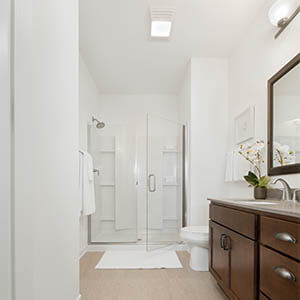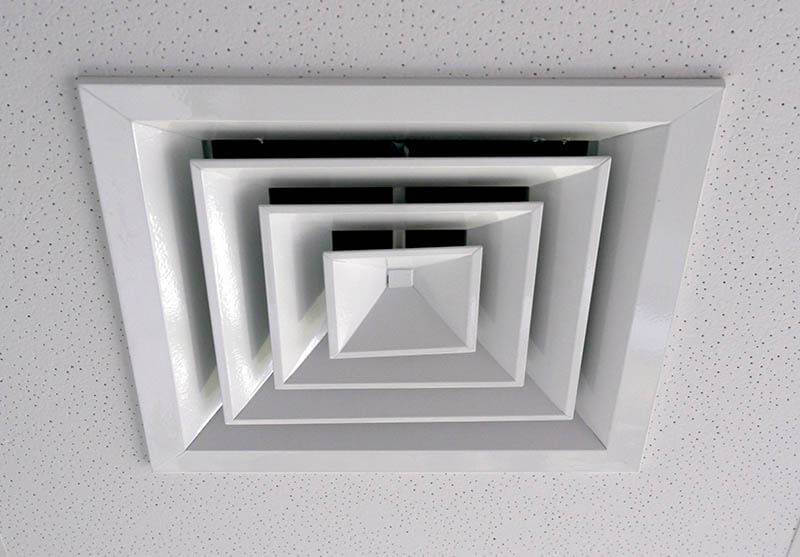Construction improvements have eliminated the infiltration of air through the walls. While that may be an energy improvement, it may not be healthy. The 2015 Energy Code addresses this, requiring whole house ventilation. An in-unit visible solution is a two-speed bathroom exhaust fan, but it is causing residents to ask – what’s that sound coming from the bathroom?
A Little History
Building construction has been chasing energy efficiency for decades. Short of a radical departure from what Americans expect from a “home” or residential building, we have achieved a point of diminishing returns with wall and roof insulation and window performance. Heating systems are typically in the 92-95% thermally efficient range. Air conditioners have ranges of “high” efficiency, depending on budget. We have been making incremental improvements in the construction industry since the energy crisis in the 1970’s which became the starting point for formal policy and legislation. That era led to the Energy Policy and Conservation Act of 1975 and the creation of the Department of Energy in 1977.
Today’s Reality
Jumping forward to the present, the latest collection of mandates and progressive thought ideas relating to building energy consumption are found in the 2015 International Energy Conservation Code. As a companion to the 2015 International Mechanical Code, these documents codify, or require engineers to design to an ever-increasing standard. This is a noble pursuit to altruistically minimize our carbon footprints, better utilize natural resources and be good stewards of the Earth. But in the world of real estate development these goals have real costs. Does lower operating and energy costs require different, possibly costly equipment on the front end? Will the building footprint and rentable area be affected by this? Thankfully, the answer is… maybe.
Time for Change
Cost aside, the real question to ask is are we prepared for change? Most of us have experienced this when shopping for lightbulbs. That aisle at your local home center looks very different than it did just a few years ago, filled with new products. The area of slowest change in the places where we live is probably the HVAC. The northern part of the country has lots of furnaces with split air conditioners. The South has a lot of heat pumps and the East Coast has a lot of boilers. While these systems are chugging away, moving the air throughout the house or apartment, and back to the filter, what’s really going on?
Historically, our leaky residential construction allowed a house to breathe. Now that we are wrapped in layers of insulation and vapor barriers and caulked gaps and joints between materials, that breathing is stifled. That means less “fresh” outside air able to come in. If there is minimal activity inside, the space can become stuffy and stagnant as evidenced by odors. On the flip side, in an active household, every time you turn the bathroom exhaust fan on, turn the range hood on while cooking or do a load of laundry, some air is being expelled and needs to be replaced.
Perhaps the best approach to this scenario would be to include an energy/heat recovery ventilator in the system. Many homebuilders are embracing this method, locating another air handling, furnace sized box in the building. This unit would have (2) fans and (4) duct connections; fresh air in, exhaust out, return air and supply air. This device will allow the flow of air into and out of the building to remain balanced and provides the additional benefit of pre-tempering that incoming air with the outgoing. The biggest downside is the added equipment space needed and the additional ductwork and intake/exhaust hoods to the exterior. In a single-family house, that is not an issue, but in multi-dwelling buildings this becomes a major cost for the equipment and installation, and a coordination headache with the intakes and exhaust terminations.

That Sound in the Bathroom
I’ve been keeping you waiting long enough, let’s go to the bathroom now. To achieve the code minimum requirement for moving air through the dwelling, we can utilize the systems and equipment already included. The bathroom already has an exhaust fan. Whether it gets used enough in many homes is another story. Many new fans are available that have two-speed settings. This allows them to idle at about 30 CFM continuously. This is fine for most locations, however in the South, this can bring in too much unwanted humidity. Additionally, we pair this continual airflow with a ducted outside air inlet at the air handler. This provides the breath of fresh air that we were lacking. By controlling this outside air with a motorized damper and interlocking it with the air handler, there is the added benefit that some amount of conditioning is being done. This prevents excessively cold or hot air from being dumped into the building. That second fan speed is for when you simply need a bathroom exhaust fan and want to get moisture and odor out.
This approach is simple and not a huge change from the way we normally live in our homes. From a builder view, it is obviously the least costly path to satisfying a new requirement. The major difference, and I’ve heard some feedback on it, is that the fan can be heard operating. The fan manufacturers have attempted to keep sound levels as low as possible at less than 1.0 sones. This can be heard in several YouTube videos like this one.
As a mechanical engineer, this machine-driven white noise is not a big deal. Apparently, some people are more sensitive to sound and prefer to live in silence. I can’t imagine not having the din of cats and dogs, the occasional child or even a spouse in the house, so I cannot imagine the silence necessary to make these fans seem obtrusive. Regardless, allowing this low-power consumption fan to run continuously will satisfy new construction code requirements while providing the benefit of a healthier home at minimal cost to the builder and owner/operator.

